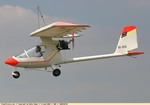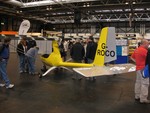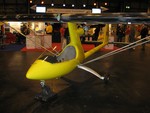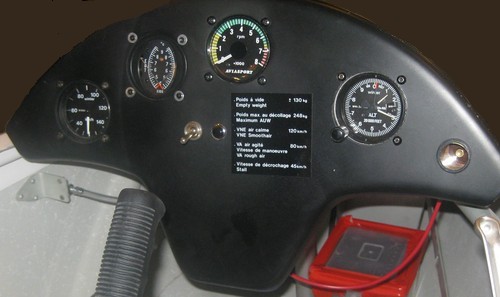
The Sirocco is a single-seat ultralight aircraft which has a pusher propeller, tricycle undercarriage, and three-axis flight controls. This page gives a little more detail on each of the components. Each section first describes a ‘typical’ late 1980s machine, with the changes in the Sirocco NG shown in green. The differences in the UK 377GB version at listed at the bottom of this page.
For a cutaway view, see this EAA article.
Fuselage & empennage
The fuselage, boom, and vertical fin form a single composite structure assembled from two moulded glass-fibre half-shells with frames for stiffening. For pictures of the fuselage during manufacture, see here ». The Sirocco NG uses the same moulds and construction, with the option of carbon-fibre instead of glass-fibre permitting a lighter fuselage weight of about 20kg. Paint adds 0.5 to 0.75kg.The rudder is similar in area to the fin, with a ground-adjustable trim tab.
The tailplane (stabilator) is a one-piece all-flying control surface which can be removed for transport or storage. A cable-controlled trim tab allows pitch trim. The 1980s construction of the tailplane included wooden ribs and bearing surfaces, which in two cases led to poor bonding with the other materials in the tailplane, which in turn led to failure in flight. The Sirocco NG tailpane has been re-designed with an all-composite structure, as shown on the right (and also here »); the latest version (in G-ROCO) has small mass-balances.
Wing
The swept wings are separate from the fuselage and can be removed for storage and transport. The leading-edge box comprises a spar and a glass-fibre and epoxy leading edge. Preformed aluminium tubes define the airfoil section (a modified MacCready TK 7315) and connect to a trailing edge anodized alloy spar; the whole being braced by internal rods and cables. The wing is covered with ‘Bainbridge’ Dacron, 170 g/mē, stretched across the wing frame and tightened with elastic cord. On the top of each wing (extending for about 50% of the span from each wingtip) is a stiffened spoiler, used for roll control (instead of ailerons).
Once mounted on the aircraft, the wings are braced with cables from a kingpost above and from the fuselage below, although some (later?) models used struts below and no kingpost (see images).
The Sirocco NG uses a newly designed wing », with a light main spar using carbon-fibre strips
and composite ribs (foam-based), leading edge, and rear spar. The
roll controls are conventional ailerons, connected in the prototype
by push-pull rods » to a control crank mounted on the fuselage. In G-ROCO a simpler
and lighter cable connection is used.
The wing is covered with Oratex UL 600 », and is supported by struts which can rotate
vertically to lie flat on the ground during assembly (there is no
kingpost).
Landing gear
The ‘tricycle’ landing gear consists of a flexible glass-epoxy arch supporting the two main wheels, and a steerable front wheel with a brake. The front wheel is steered by a lever on the right in the cockpit, which can be locked in the central position for takeoff and flight.The Sirocco NG has a free-castoring nose wheel (lighter and allowing more room for the adjustable rudder pedals); differential brake levers adjacent to the throttle lever on the left are used for braking and for ground steering.
Cockpit & controls
The cockpit has a fixed polycarbonate windshield and a fully-removable canopy, which allows flying en torpédo (without the canopy) in warm weather. The reclining seat is fixed (but the rudder pedals can be adjusted to suit the pilot).The primary 3-axis flight controls comprise a conventional control stick at the front centre of the seat and pedals that control the rudder (only).
Other controls include throttle, trim, and choke levers on the left side of the cockpit, and the front-wheel steering lever (cental locking and with brake lever) on the right. (In the Sirocco NG the steering lever is replaced by differential brakes, see above.)
The instrument panel is shaped for the cockpit. The panel shown here includes Air Speed Indicator, engine temperatures, engine speed, and altimeter gauges, together with a master switch and 12V socket.
Powerplant
A variety of powerplants have been used or proposed for the Sirocco. Two-stroke engines include the 24 hp Koenig 43ORD, the 26 hp JPX PUL 425, the 35 hp Rotax 337, and the 40 hp Rotax 447. The Sirocco NG also has a 4-stroke option, the 33 hp ParaZoom-Power V2 » Briggs & Stratton 630cc engine from ParaZoom », and is also offered with the 24 hp Cors-Air M25Y engine. G-ROCO currently uses the lighter engine to stay within SSDR weight.
See specifications for some more details and performance measurements.
Other
Options include a variety of instruments, a ballistic recovery system (whole-plane parachute), larger fuel tank, various propellors, canopy, etc.Midland Ultralights 377GB version
The 377GB version (1985, type approved by the BMAA ») had a number of differences in order to satisfy the UK airworthiness authorities. These included:
- strengthened nose wheel gear
- thicker control and leading-edge cables
- a piano-style hinge on the trim tab
- stops on the controls
- different rudder pedals
- extra noise-reduction
- fuel drains and taps
- fuel level sight gauge.



